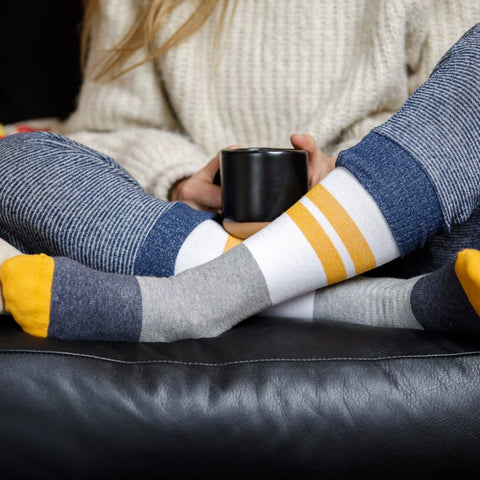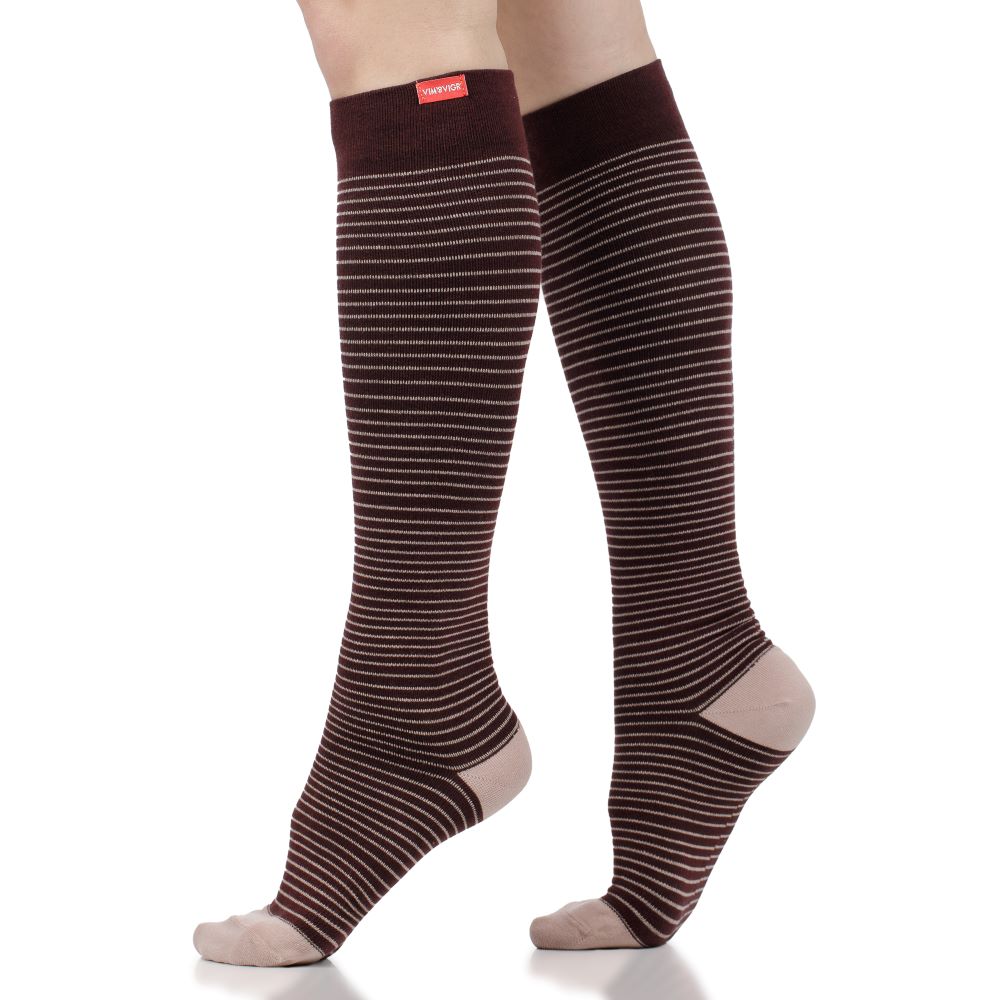Compression Socks for Flat Feet: The Benefits & How They Work
Flat feet are not a myth: in around 20-30% of people, the arches never developed as much as for the rest. This means they’re more likely to roll their ankles inwards when walking and they’re putting more weight on the arch of their feet. While this may not always be painful, it can cause discomfort or even, sometimes, sharp pain. And it could get progressively worse, depending on your activity levels and personal condition.
Can compression socks help flat feet? Thanks to gentle pressure applied to the arch of the foot, compression socks add a little support to the area. They also boost peripheral circulation, helping reduce inflammation, swelling, and foot pain.
Read on to find out more about the relationship between flat feet and compression socks.
Can Compression Socks Help Flat Feet?
Compression socks provide two big benefits to the lower limbs: gentle support and increased blood flow. They support the ankles and feet during walking, running, or simply standing or sitting for long periods of time. Through the pressure they apply on the veins, they stimulate blood flow in the limbs, preventing swelling and pain, while also reducing inflammation and discomfort.
People with flat feet will benefit from arch support in varying degrees. For more serious conditions, compression socks are insufficient and specific shoes or insoles will be needed to lift the arch. But, in all cases, the added tight grip of a compression sock on the foot delivers support and a boost in confidence. Moreover, the increase in blood flow to the area helps reduce inflammation from over-soliciting the arch. Overall, compression socks contribute to reducing the symptoms of flat feet and improving the comfort of feet, ankles, and lower limbs.
What Are Flat Feet and What are the Symptoms?
Flat feet (or flatfoot) refers to a condition where the arches of your feet flatten when you put weight on them. It’s easy to figure out if you have it: simply look at the marks you leave on the floor if you walk barefoot after taking a shower, with your feet still wet. Many people can see a gap where the inside of their feet is - that means they have high arches. However, if your foot print is more uniform, including the inside of the foot, then you have flat feet.
Although we call it a “condition,” having flat feet doesn’t usually mean you have a medical problem. In fact, most people go through life without even considering it! It’s usually painless and doesn’t affect your walking pattern or cause pain. A further complication can be plantar fasciitis - inflammation and pain in the arch of the foot.
However, for some people, flat feet cause the foot to point outwards, the ankle to roll inwards too much, or simply pain in the arches of the feet. In these cases, it’s a good idea to consult with a podiatrist.

What are Compression Socks and How Do They Work for Flat Feet?
Compression socks apply therapeutic pressure to the lower limbs, usually from the feet up to just below the knee. This produces a feeling of support and stability, especially in cases where people return to sports after injuries. It also soothes sore muscles and helps to prevent issues like shin splints in runners.
But one of the most important actions of graduated compression is the boost in peripheral circulation. Through squeezing tighter at the ankles and less at the knees, the gradual compression stimulates blood flow up towards the heart, defying the pull of gravity. This is very important for those who spend long periods of time on their feet, as it reduces the risk of blood pooling around the ankles. As a result, there’s better circulation throughout the body.
This circulatory benefit means that a bigger volume of blood flows through the feet. This can help calm down inflammation and soothe pain. It also prevents feet and ankles from swelling and causing more discomfort as you stand or sit for extended stretches of time.
Finally, compression socks have a tight, reassuring grip on the feet, ankles, and calf muscles. This doesn’t replace the effects of an insole designed to add arch support for flat feet, but it does offer some protection and lift - and can work really well with an insole or with dedicated shoes with extra arch support.
The Benefits of Compression Socks for Flat Feet
We’ve seen that compression socks work in two major ways: supporting muscles and joints, on the one hand, and boosting blood circulation, on the other. These actions both deliver benefits to people with flat feet.
Arch Support
Of course, the ideal level of arch support for flat feet, especially if this is a major problem for you, is provided by specific shoes or podiatrist-recommended insoles with an added lift under the arch of the foot. However, compression socks can also play a small part in this.
They can help prevent the ankle from rolling in too far and reduce some of the effects of a weak arch when walking or running. They also help support the ankle joint, which is especially helpful when coming back from injury or for injury prevention.
Improved Blood Circulation
The key benefit of wearing compression socks is the boost in peripheral circulation. The increase in blood flow to the feet and lower legs reduces the risk of swelling and discomfort caused by blood pooling in the area. Moreover, those who suffer from cold feet because of poor peripheral circulation can reduce the incidence of this discomfort thanks to compression socks.
With better blood flow comes a quicker recovery period. Blood delivers more nutrients and oxygen to every cell in the body, which means that muscles take less time to recover. This is also important for flat feet. With an extra delivery of oxygenated blood, sore feet and arches can feel better after a long day out - getting ready for the next one.
Reduced Pain and Swelling
Flat feet can lead to pain in the arch of the foot, as well as to ankle swelling. This is caused by repeatedly rolling the ankle inwards too much when you walk or run, and consequently stepping into your weak arch. Wearing compression socks during exercise or walking can help add support to both arch and ankle and reduce the likelihood of swelling and pain setting in. After exercise, the boost in blood flow provided by compression socks will help bring down inflammation and soothe aches and pains.

Tips for Using Compression Socks for Flat Feet
You can wear compression socks at multiple moments of the day, either before or after exercise, or during any activity, to prevent or calm down any complications from having flat feet.
How Often to Wear Compression Socks for Flat Feet
There is no particular limit to how often you should wear compression socks. In fact, once you’re comfortable in them, you can pretty much wear them every day. The key is how you feel and how they act on the lower limbs.
We recommend wearing your socks as a preventative measure to reduce the risk of swelling and discomfort from flat feet. This can mean putting them on when you go for a run, a hike, or a walk. You can also wear them at work, especially if you stand a lot and put extra weight on your arches.
Many people find compression socks to be especially beneficial during recovery from an effort - whether that’s after working out or after spending a long time on your feet during a busy work day. In these cases, you could wear your favorite pair while you relax in the evening, pretty much every day.
How Long to Wear Compression Socks for Flat Feet
Compression socks and stockings are very comfortable and soothing. However, the feeling of squeezing your legs and feet can be a little strange the first time you try them on. As long as they fit well, there’s no limit to how long you can wear them. But you should start with a couple of hours on your first wear, then a little bit longer incrementally, as you feel comfortable.

Choosing Compression Socks for Flat Feet
To ensure you get all the benefits of compression, you need to consider a few factors.
Determining the Right Level of Compression
Not all compression socks are the same! There are several levels of compression, measured in mmHg, from everyday wear to medical grade.
For most people, especially when you wear them for prevention, moderate compression (15-20 mmHg) is enough. However, if your doctor suggests it, you may want to wear firmer compression socks (20-30 mmHg), which are designed to also treat the symptoms of moderate edema, deep vein thrombosis, or varicose veins.
Choosing the Best Compression Sock Type
There’s also not just one type of compression sock. The knee-high style is the most common, but you can still benefit from compression support to your arches by wearing open-toe socks or stockings which let your toes breathe. These can be great for dancers or for wearing in the summer with open-toe shoes. For wider coverage above the knees, you can also opt for compression tights.
Finding the Right Size and Fit
Without the right fit, compression socks won’t really deliver much of a benefit. If they’re not tight enough, they don’t give you any support, whereas if they’re too tight, they risk cutting off your circulation and will be uncomfortable.
To make sure you are wearing the right size, follow a sizing guide and start by measuring the circumference of your calves. It’s also important to put them on carefully, ensuring that the toes and heel are nestled in correctly and that there is no bunching or pulling of the material. Smoothe them against the skin once they’re on to make sure.
Considering Fabric and Materials
With compression socks, as with any type of garment, fabric matters a lot. Cotton is extremely versatile and can give you lots of options for putting together cute outfits, but there’s more to choose from.
Most athletes will benefit from wearing nylon compression socks that are thinner and sleeker than cotton. They mould to the feet and ankles a little more and move with your body, so you can barely notice them.
Finally, for all-season moisture-wicking, you can’t go wrong with merino wool socks. They are antibacterial and hypoallergenic, and they regulate temperature so you’re not too hot or too warm while wearing them. Couple that with the gentle support and blood flow boost and they’re the most multitasking socks you can find.



















Leave a comment